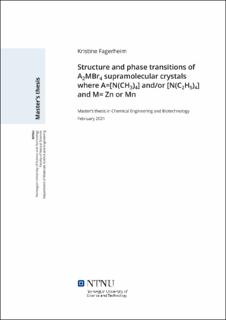| dc.contributor.advisor | Einarsrud, Mari-Ann | |
| dc.contributor.advisor | Walker, Julian | |
| dc.contributor.author | Fagerheim, Kristine | |
| dc.date.accessioned | 2021-09-28T18:17:01Z | |
| dc.date.available | 2021-09-28T18:17:01Z | |
| dc.date.issued | 2021 | |
| dc.identifier | no.ntnu:inspera:65717140:50486717 | |
| dc.identifier.uri | https://hdl.handle.net/11250/2785307 | |
| dc.description.abstract | Behovet for mindre, mer bærekraftige og elastiske elektriske innretninger har økt interessen for å finne erstatninger for konvensjonelle ferroelektriske materialene som ofte er sprø og har en lite energieffektiv produksjon. Imidlertid har plastiske krystaller vist, en type supramolekylære materialer, en mesofase som muliggjør forming og bearbeiding ved moderate temperaturer. I den forbindelse har seks nye komposisjoner, A2MBr4 hvor A = [N(CH3)4] og /eller [N(C2H5)4] og M = Zn eller Mn, av organisk-uorganiske krystaller blitt fremstilt gjennom en krystalliseringsmetoden som starter med en vandig løsning etterfulgt av langsom fordampning ved rom temperatur. Målet for dette prosjektet var å forstå hvordan komposisjonen påvirket strukturen og dermed hvordan strukturegenskapene til disse materialene kan justeres. For dette formålet ble sluttproduktene karakterisert ved røntgendiffraksjon (XRD) og differensial skanningskalorimetri (DSC). XRD analyse ble gjort for å bestemme strukturen til komposisjonene, mens DSC analysen bestemte faseovergangene under kjøling og oppvarming av materialene. Entalpi ble beregnet for å bestemme energien som ble brukt i overgangene. Resultatene viste at:
• Kationstørrelsen hadde en stor effekt på materialets struktur, og endret materialets
symmetri og romgruppe.
• Anionet som ble brukt, hadde en merkbar, men mindre effekt, og ga volumendring
i enhetscellen som tilsvarte anionstørrelsen.
• Et komplekst utvalg av faseoverganger ble observert mellom -25 og 240 °C som
viste både endring i orden-uorden og forflyttinger i strukturen som følge av
endring i komposisjonen. Det organiske kationet hadde den størte påvikningen
på disse endringene. | |
| dc.description.abstract | The need for smaller, more sustainable and flexible electrical devices have increased the interest to find replacements for the conventional metal oxide ferroelectrics which are generally brittle and have a non-energy effective production. However, plastic crystals, a type of supramolecular materials, exhibit a mesophase which makes shaping and processing at moderate temperatures possible. In this regard six new compositions, A2MBr4 where A = [N(CH3)4] and/or [N(C2H5)4] and M = Zn or Mn, of organic-inorganic crystals were made through a crystallization method starting with an aqueous solution followed by slow evaporation at room temperature. The aim for this project was to understand how the composition influenced the structure so that we might better understand how to tune structureproperties of these materials. For this purpose, the final products were characterized by X-ray diffraction(XRD) and differential scanning calorimetry (DSC). The XRD analysis was done to determine the structure of the compositions while the DSC analysis determined the phase transitions during cooling and heating of the materials and the enthalpy was calculated to determine the energy used in the transition.
The results showed that:
• The cation size had a large effect on the structure of the materials, effectively
changing the symmetry and space group of the material.
• The anion used had a noticeable but smaller effect, producing a volume change
in the unit cell corresponding to the anion size.
• A complex array of phase transitions was observed between -25 and 280 °C
displaying both order-disorder and displacive characteristics depending on the
composition. The organic cation played the largest role in influencing this
behaviour. | |
| dc.language | eng | |
| dc.publisher | NTNU | |
| dc.title | Structure and phase transitions of A2MBr4 supramolecular crystals where A=[N(CH3)4] and/or [N(C2H5)4] and M= Zn or Mn | |
| dc.type | Master thesis | |
